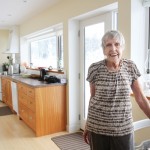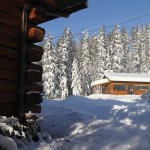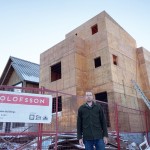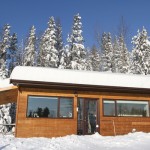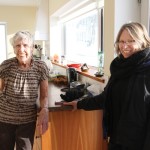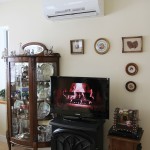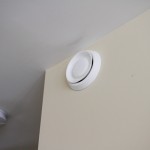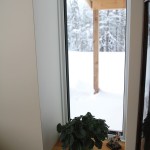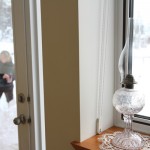By: Laura Keil
The mission given by Clara Lopeter was simple: build a very small energy-efficient house for about $100,000.
Valemount native Erik Olofsson was up for the challenge.
A Passive House trained builder, Olofsson knew this house would be too small to qualify as a Passive House. But he used a lot of the same techniques to build Lopeter’s home – triple glaze windows, foam insulation, super-thick walls and an air-tight envelope. The house received two certifications – R-2000 and Built Green, Platinum.
The 600sq ft home is now nominated for a Georgie Award from the The Canadian Home Builders’ Association of British Columbia. Georgie Awards recognize excellence and innovation in home-building and renovation.
Olofsson’s work is nominated under the category “Best Affordable Certified Home – Production or Custom.” He’s up against three other contenders in the category, all in the lower mainland. Winners will be announced Feb 27th at a gala in Vancouver.
Olofsson says the Passive House-style construction he used, or certified Passive Houses, are not high-tech in design. It simply takes the construction to the next level in the walls, ceiling, windows, doors, and insulation.
“The vast majority of houses are built to code minimum,” he says. “These houses are using proven building science to build it better.”
Lopeter had just taken some muffins out of the oven last Friday around noon. Her daughter Rhondi Hurlbut was outside shoveling a path from her place to her mom’s. Lopeter’s house is small enough to qualify as a secondary residence on her daughter’s property.
Hurlbut comes in and they recall the time last winter when it was a sunny -35 degree day. Hurlbut’s place, a cute log cabin style home, still felt drafty despite the furnace running at full tilt. Hurlbut dropped by her mom’s to ensure she was warm. She was. In fact, Lopeter had opened the windows because, with the sun shining through the south windows and her indoor heating, it had suddenly become too hot.
Lopeter uses an air source ductless heat pump (not geothermal) to heat or cool her home and also has a heat recovery ventilator, which cools the stale air leaving her house, and warms the fresh air coming in.
On Friday the heat fans out from the heat pump as hot as it would from a fireplace. The only fireplace, however, is on the TV. The TV stand? Modeled on an antique stove.
The sun hitting the south facing windows also brings in a lot of warmth during the day. The windows are a net energy gain, meaning that over the course of a year, they bring in more energy than they lose.
Because of the thermal envelope of the house being air-tight, the house needs a good ventilation system. Instead of air creeping in through cracks, all air entering the house comes through a filtered heat recovery ventilator. This means the air quality in her place is much higher, and she’s spending less energy heating cold air from outside.
As a backup, she does have electric baseboard heaters, and uses propane for her on-demand hot water tank. All her appliances are high-efficiency.
Another benefit for Lopeter is that the house is all on one level – even the shower is completely accessible with no curb between the floor and the shower.
Olofsson is passionate about building green homes and says a lot of homeowners and builders may not be aware of the options today. He says a lot of people will stick to what’s familiar. But with energy prices rising, he believes more people will see the financial case for super efficient homes. It’s also greater accountability for the builder.
“If you go to a car lot, by law that car has to have a sticker with exact emissions and fuel consumption; but if you buy a house and you ask the builder how much it will cost to heat/cool, he/she won’t have a clue, because they don’t model the house. With Passive Houses, we model the house, so at the design stage we’re able to say, ‘You’ll use this much per year per square foot.’ It’s remarkably accurate.”
He also remarks that buildings are one of the biggest contributors to global climate change, contributing to about half of emissions in North America due to demands like heating and cooling.
A Passive House or Passive-style home will generally cost about 10% more than code minimum to build. But he emphasizes that the savings begin immediately, and more than cover the extra payments you’d make in a bigger loan.
“As a builder that’s trying to sell houses, I’d like to emphasize that it’s doable. It’s not exotic. You don’t have to be afraid it will cost you a bunch of money.”
A Passive House is designed to use 90 per cent less energy than a typical older code minimum house and about 70 per cent less energy than a brand new code-minimum house. Lopeter’s house uses 50 per cent less than a similar code minimum house, according to Olofsson’s calculations.
The proof is in the pudding – or in this case Lopeter’s BC Hydro bill. It was $60 for the past two months.



